Melbourne: Our Creative Heart exhibition
Creativity Cluster artists display their artworks
The exhibition Melbourne: Our Creative Heart ran from 9 November – 1 December 2022 at the Library at the Dock gallery in Docklands.
This exhibition, supported by a City of Melbourne Arts Grant, portrays the many ways that Melbourne nurtures our creativity.
The seven participating artists are members of Creativity Cluster, a group established in 2018. We developed our artworks by experimenting collaboratively across each other’s mediums, as well as by working individually.
The exhibition has four distinct but interrelated themes: People, Place, Culture and Vitality.
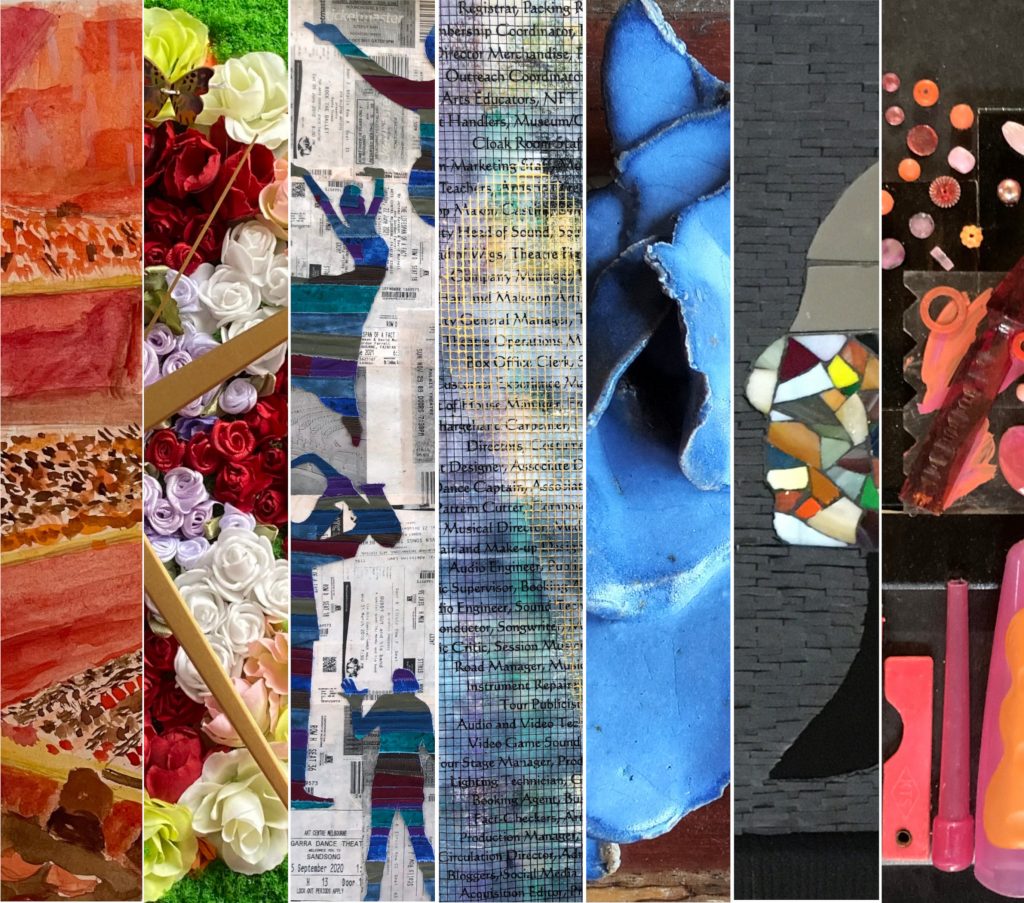

People, Place, Culture, Vitality
The people who inspire us include performers, artists, writers, behind-the-scenes creatives, support workers and, of course, the audience, without whom there could be no engagement.
Place includes the many physical structures that inspire us, both for their architectural design and the cultural institutions they house. Place also includes natural features, such as Melbourne’s famed parks and gardens.
Melbourne’s culture embraces and celebrates the arts, sport and fashion, as well as Indigenous and migrant customs and traditions. And let’s not forget Melbourne’s vibrant cafe culture – and the best coffee in Australia!
People, place and culture combine to generate the vitality – the colour and movement – that makes Melbourne one of the most liveable cities in the world.
The artists have used several recurrent motifs – silhouettes, mirrors, domes and arches – to develop and integrate these themes.
Finally, a symbolic winding river connects our works to each other and to those aspects of Melbourne that most inspire our creativity.
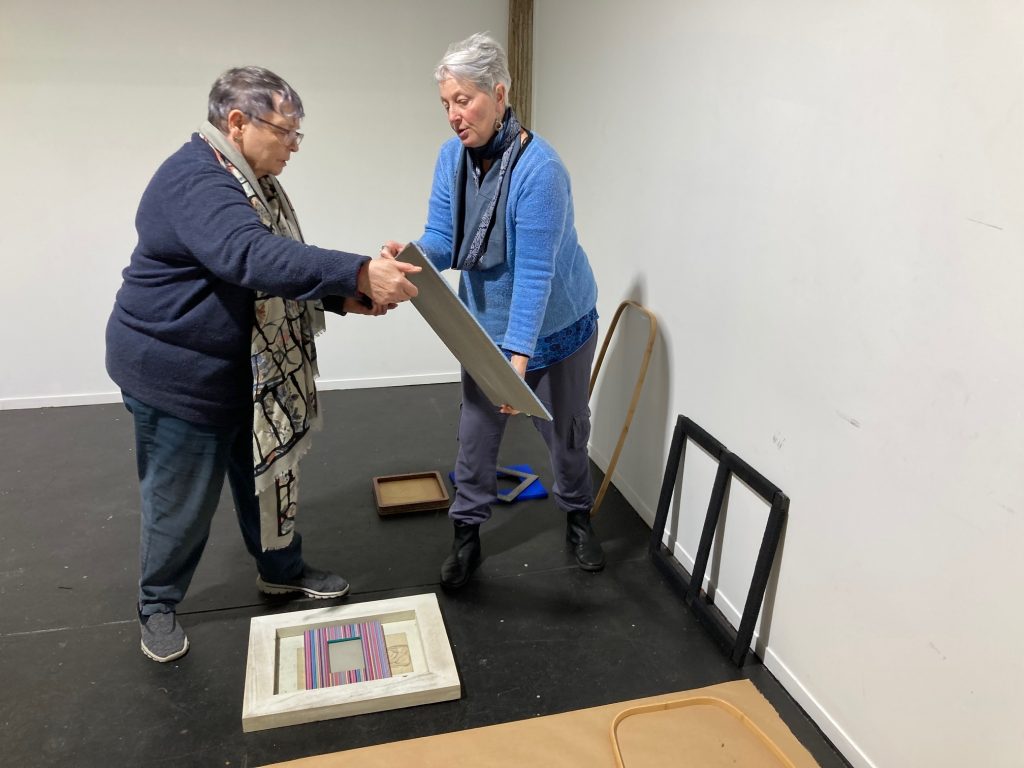
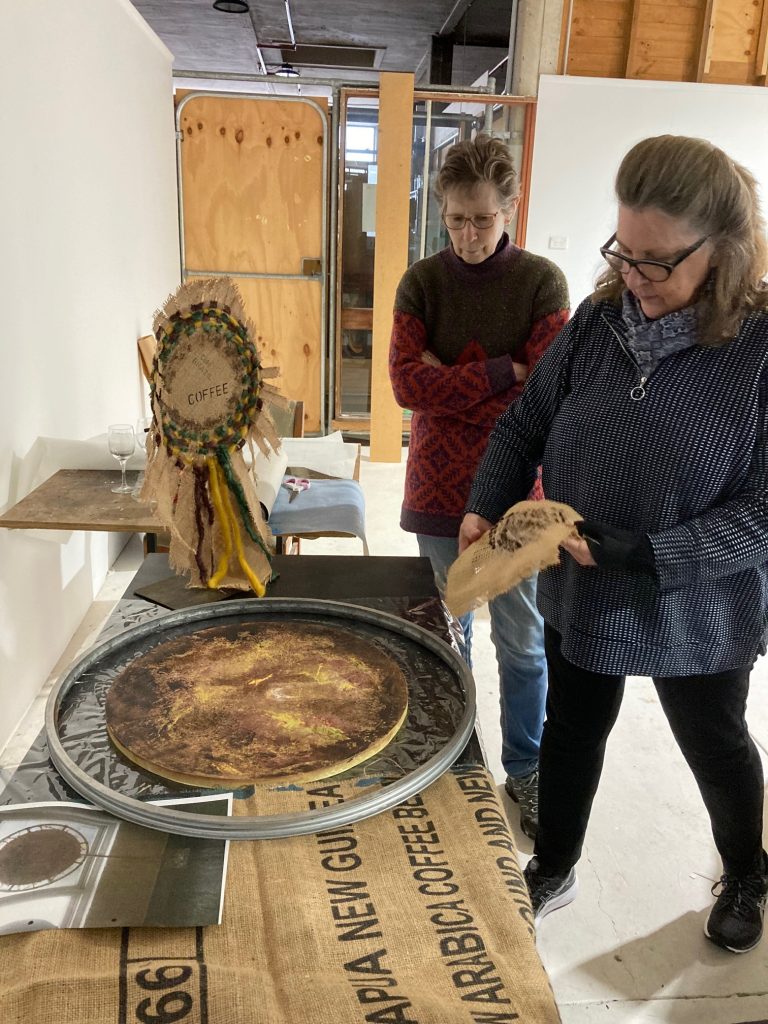
Our City by Deidre Ogilvie
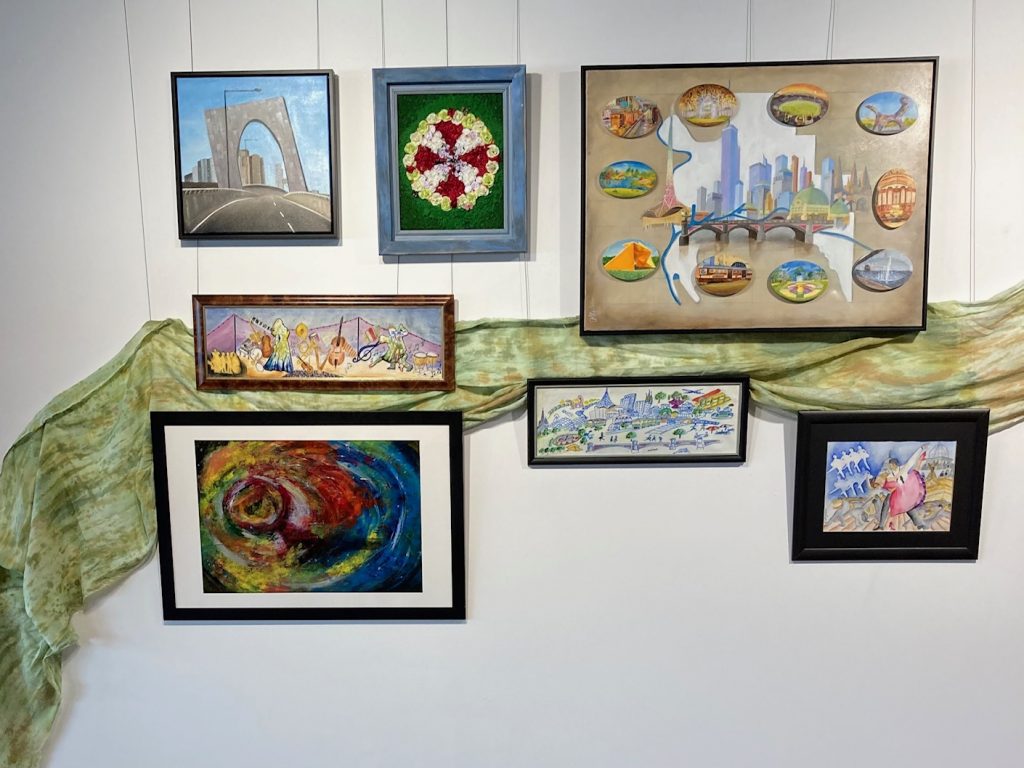
In the beginning, there was the ‘Creative Heart’ (bottom left) of our city. Melbourne, our city of incredible and beautiful architecture and sculptures. With the Yarra River joining together our diverse city, from street art to fine arts, it is unlike any other city in the world.
The main work in this cluster (top right) is based on a map of the City of Melbourne (see blog) overlaid with our distinctive skyline as viewed from the banks of the river. Also included are our city’s landmarks and gathering places. This archway (top left) at the entrance, on the west side of our city, symbolises the city’s welcome to all.
Few places are visited as often in our garden city as the floral clock (top centre). Situated outside the NGV, it connects our fine arts gallery with our garden city. Melbourne’s blooming timepiece in Queen Victoria Gardens showcases our creative gardeners.
The Music Bowl (middle left) is a symbol of our talented music performers; this outdoor venue, for all creative performers, is situated in one of our city’s beautiful gardens. The audience, seated on the lawns, become part of the performance. This is a painting on fabric, highlighted with embroidery by Lindsay Hussey.
Melbourne’s iconic Princess Theatre, regarded by many people as our most spectacular landmark dating back to 1854, is a symbol of our theatrical performers (bottom right) at their best.
The landscape (bottom centre) and climate of our city is open to all sorts of indoor and outdoor pursuits. From our sporting fields to the Spiegel tent, our galleries to outdoor eating venues, all add to our vibrant and creative city.
Vim, Vigour and Vitality by Nancy D Lane

This cluster represents Melbourne’s vitality, colour and movement, all of which stimulate our creativity. Most of the Creativity Cluster artists are represented in this cluster (see blogs with Deidre Ogilvie and Pat Duncan), although the common thread is the assemblage objects I have found on Melbourne’s streets. Most of the works are experimental, with artists working together across mediums.
The work ‘Inspire, Aspire’ (centre) suggests the dynamic Arts Centre spire. Despite roughly similar proportions, this depiction challenges the materials and colours of the original. ‘Urban Verve’ (top left) implies movement, a city grid of the imagination. Penny Sharples applied oil and cold wax to suggest grittiness. The aerial view is created using street cleaner bristles as streets and metal pieces as buildings.
‘Sky’s the Limit’ (top right) celebrates Melbourne’s special nights, with a city skyline and fireworks in myriad shades of red, pink and orange. Melbourne itself is colourful, despite most Melburnians seeming to dress in black. This is acknowledged jocularly in ‘Red Letter Day’ (bottom left), with ‘colou’ spelled in black before a red letter ‘R’ announces a riot of plastic bottlecaps in primary colours.
Flowers emphasise the hues of Melbourne’s renowned parks and gardens. ‘Unearthly Bloom’ (centre, furthest right) is a pink hydrangea painted by Pat Duncan, with falling hairclip petals. ‘Blue Delphinium’ (bottom right) is part rose mystericus, a little Dignity Blue Delphinium and a touch of Cornflower. Mardie Whitla hand built this ceramic piece and mounted it on a found wooden frame.
Finally, ‘All Heart’ (centre, right of spire) recognises the importance of everyone’s creativity, no matter its form. This work comprises a ceramic heart puzzle strewn with plastic, glass, metal, diamante, wire and paper hearts, all collected from the streets of Melbourne. The mirror backing enables viewers to see themselves for their own creativity.
Inspiration by Luna Cameron-Parrish
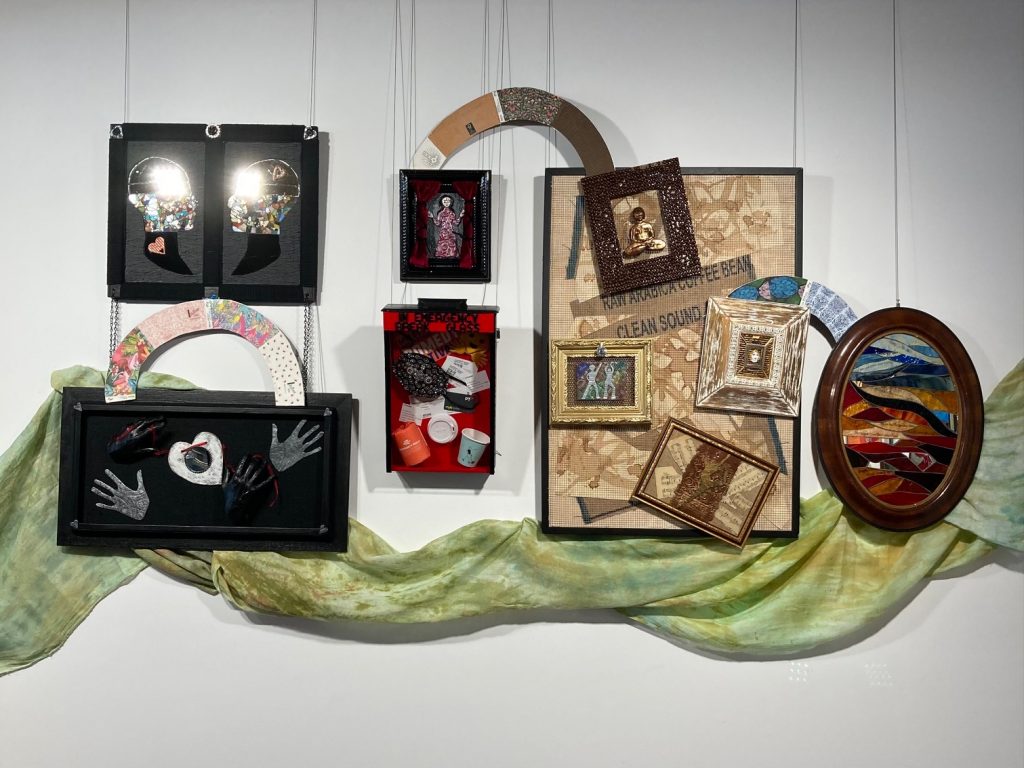
In exploring Melbourne’s Creative Heart, my initial thoughts gravitated towards the creative process. Beauty already exists in the natural world, but creativity requires some degree of analysis, interpretation, and application. To manifest abstract ideas into reality involves mental and physical action by the creator/s. It may also include dialogue, conversation, or debate.
Creativity is an essential part of the human condition; it permeates all aspects of our lives. Yet, within the arts we focus more on playfulness, imagination, and connection, rather than looking for practical solutions to everyday problems.
Connection is crucial, involving not just the creator/s and their supporters, but also a general population. Engagement with an audience gives the arts their place in our society. Without engagement, art is an act of solo expression; it is engagement that creates a collective cultural heart.
The work I have made for my cluster reflects these ideas; beginning with two people having a dialogue, an exchange of ideas; or perhaps it is one person having an internal dialogue? The physical manifestation of ideas is represented by hands, the most effective tools that I have for creation. This physical process is connected to the mental/intellectual.
Several pieces represent inspiration, which for me are archetypal – generic ideas that I interpret in my own fashion. The “emergency” box is very Melbourne-specific, designed to humorously reflect the challenges of the past few years.
The final work is an homage to the creativity of others who have come before; those who continue to inspire and delight with the legacy they have left behind. They have made their mark on Our Creative Heart.
My cluster is connected by coffee cup arches. Both the coffee and the arch shape are iconic parts of Melbourne culture, and the unique art adorning the cups seems appropriate given the subject.
Culture by the Yarra by Pat Duncan
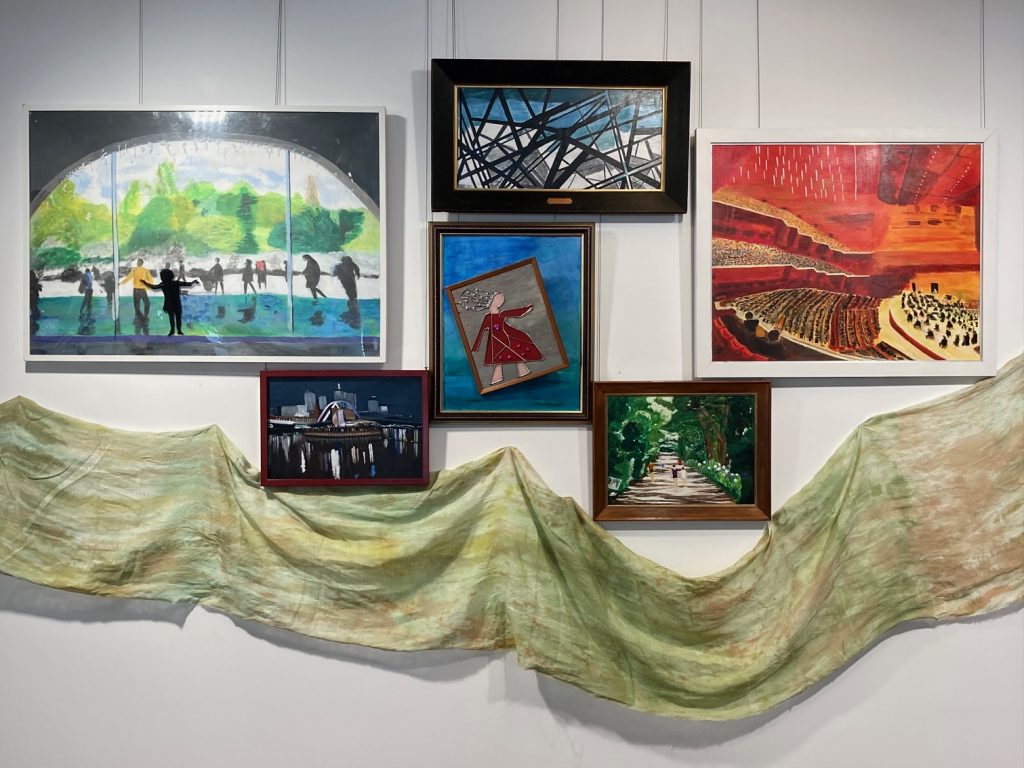
This collection shows Melbourne places and activities bordering the Yarra River. The paintings depict people passing by on the way to and from work, enjoying themselves at a concert, having coffee or just walking or running in the greenery of the Botanics. They highlight the wonderful architecture of the public buildings and the attractions that bring people into the city and give it vibrancy.
The artworks were constructed using recycled frames, heavy cardboard from a theatre set, plywood, Perspex, backing board and foamboard. Some were painted in oils, and the larger ones in acrylic and mixed media.
- There is always activity at Hamer Hall, attracting many patrons and performers to the Auditorium (top right).
- The Waterwall (top left) at the entry to the NGV International cannot be ignored. A meeting place before exhibitions, it also catches the eye of commuters. Children love to play with the water streaming down the outside window.
- A magical place to have a coffee, drink or snack is Ponyfish Island (bottom left) in the Yarra, hidden under the footbridge between Flinders Street Station and Southbank.
- The Tan (bottom right) is a running/walking track looping the Botanic Gardens. Close to the Arts Precinct and City Centre, it is popular before and after the working day and at the weekend.
- Federation Square is an amazing edifice. The structure of the Atrium (top centre) is seen in detail from an upper window in the National Gallery of Victoria Australia.
- The flying girl as a silhouette (centre) is taken from the stainless steel sculptures on Sandridge Bridge over the Yarra. The girl as sculpted by Nadim Karim is titled ‘Refugees’. This representation uses wire to profile the body, but adds beads and hearts to portray the optimism and excitement of a new life.
Ensemble by Lindsay Hussey and Penny Sharples
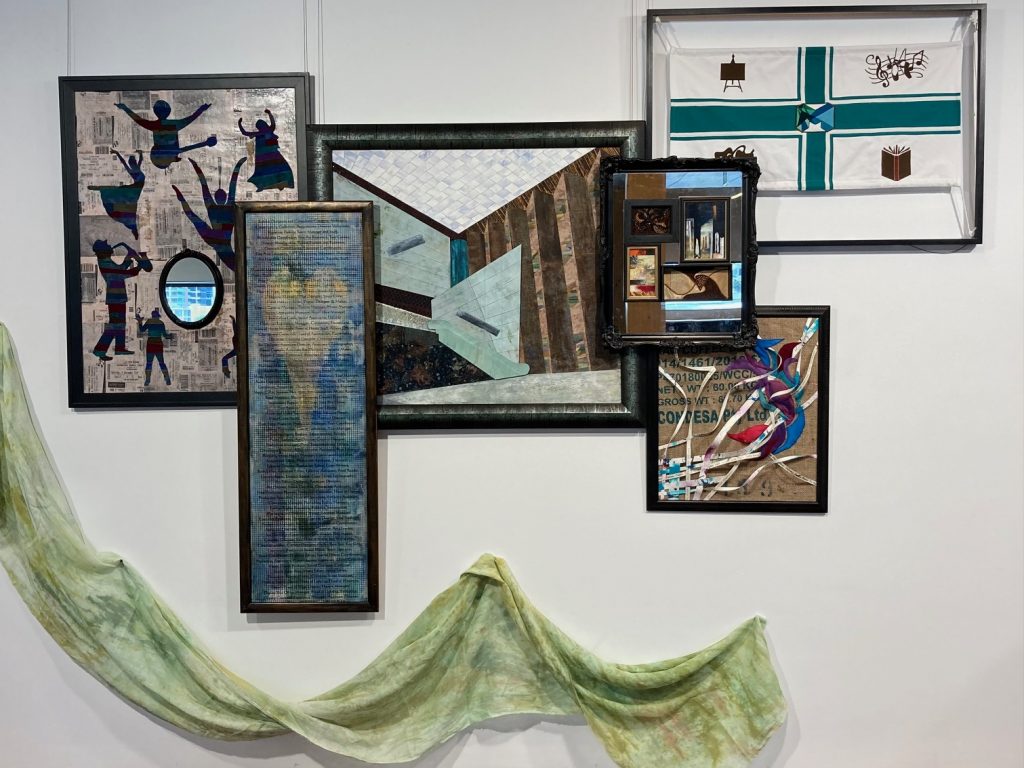
We consider People as the heart of Melbourne’s creativity. While of course acknowledging the artists, dancers, musicians, actors, etc., we particularly want to honour the many, many people behind the scenes . Although often overlooked, they are vital to the creative process.
Equally vital is the audience. Mirrors draw the audience in, to see themselves within the art. No longer passive observers, their images, no matter how fleeting, complete the artwork.
We also recognise the importance of our arts institutions to Melbourne’s creative culture: providing a home, support and inspiration; juxtaposing the architectural form of the NGV Federation Court with the creative community.
It’s hard to think about Melbourne without a nod to its coffee culture – references to the coffee culture are layered throughout this installation.
Finally, reflecting on the central importance of the arts culture to today’s Melbourne, we re-imagined the City of Melbourne flag (top right). We have offered the new symbols of art, dance, music, theatre and literature to replace the old – livestock, whaling and shipping.
The City of Melbourne’s Arts Grant Program afforded us the opportunity to grow our creative endeavours. It provided time to experiment (see blog), make mistakes, be vulnerable and push against self-imposed limitations, which provided an insightful learning experience.
We thank Nic Pitman of Frame Harbour for his generous supply of recycled frames and materials. We also thank Ron Irwin for assistance with installation construction.
Welcome to Melbourne by Mardie Whitla


The land of the Wurundjeri people prior to European settlement, the Yarra River has a strong Aboriginal story. Between the Dights Falls at Abbotsford down to the center of Melbourne city, you might find up to 15 species of fish. Maybe catch a Golden Perch, a Brown Trout, a Redfin or even a Bream.
Coming back to Melbourne after months away from home, invariably my heart flutters as I reach the Melbourne Gateway and drive under the red sticks and the long yellow gate. It’s especially wonderful at night.
Centrepieces
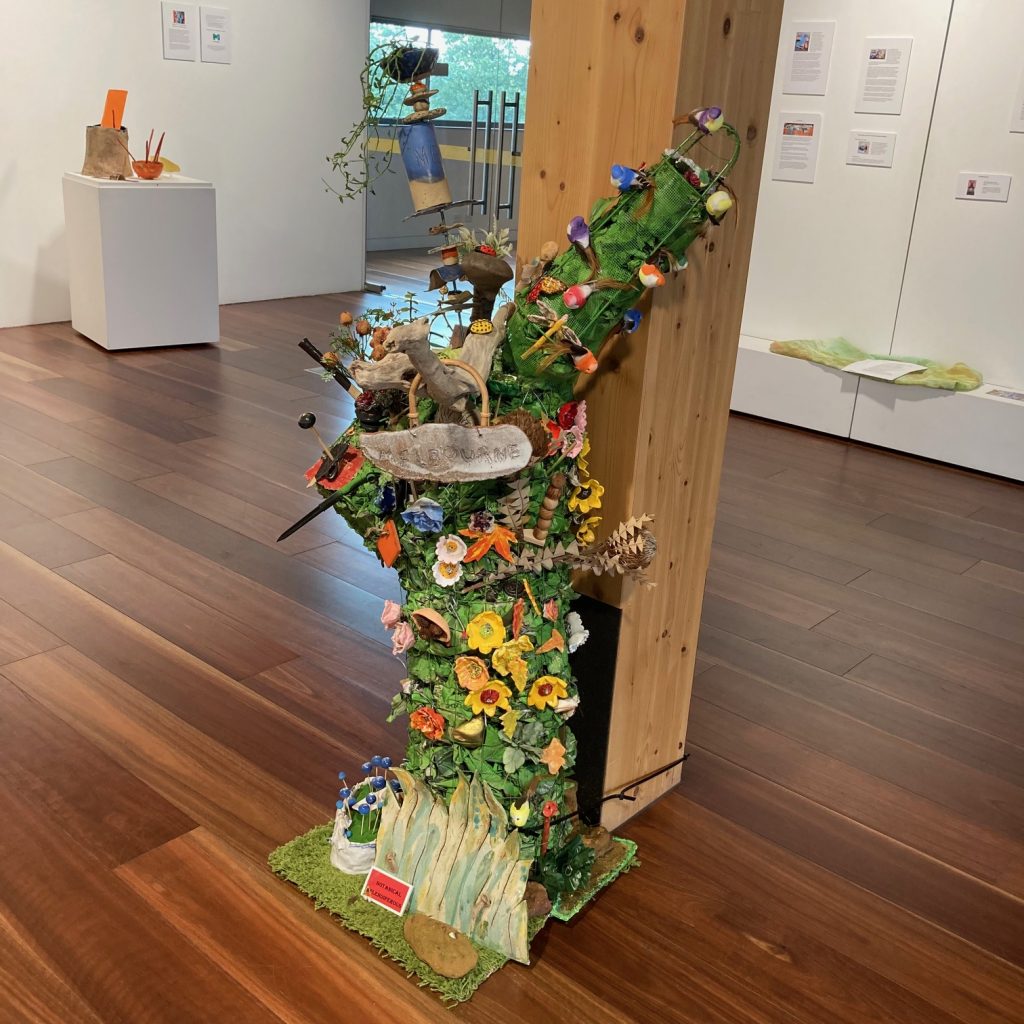

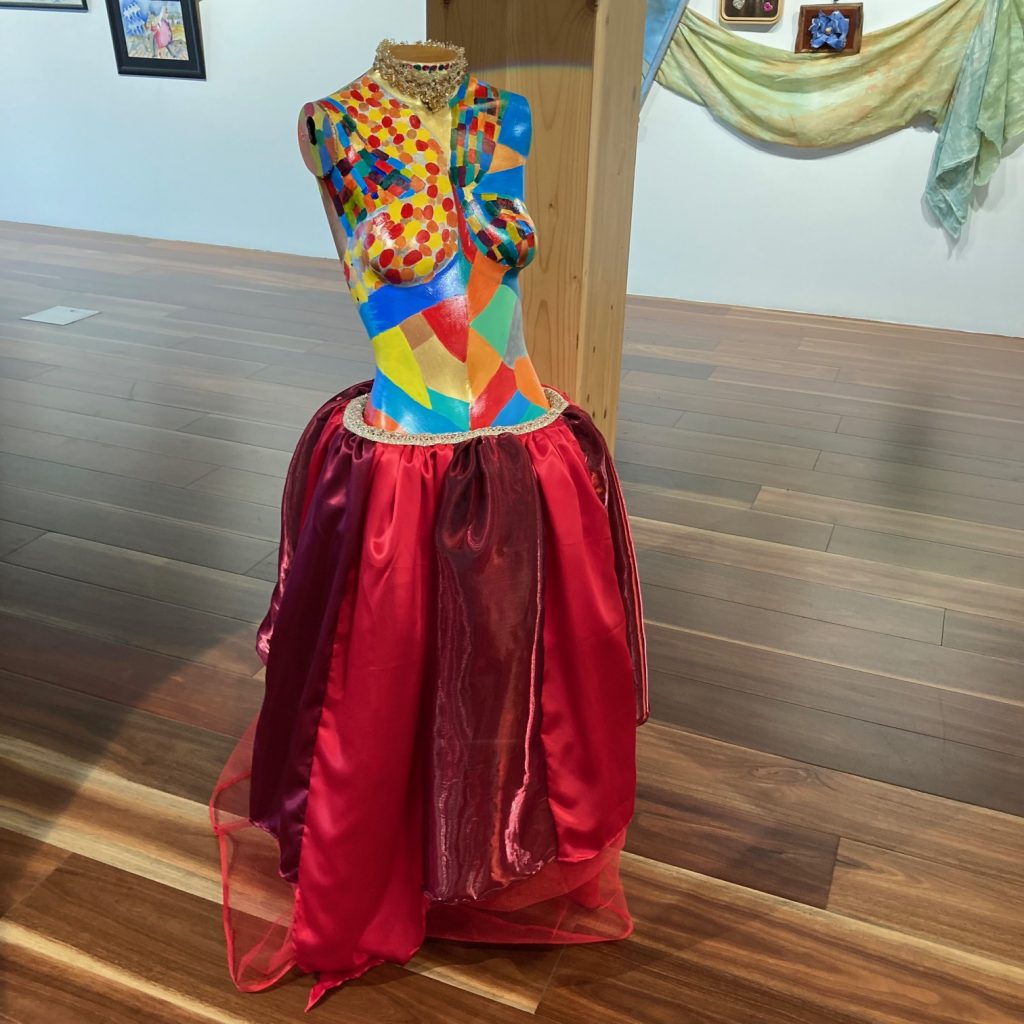
Our shared enjoyment of Melbourne’s gardens, the centrepiece of our state, inspired our colourful 1.5 metre installation Botanical Splendiferous (see blog). Over many hours together using our diverse artistic skills, creative imagination and some local found multi-purposed objects, our “garden” has erupted into an entertaining wonderland of our Garden State.
If you look closely, you might find a favourite flower, some entertaining rocks or plants, tree branches, a lake, works of glazed clay, or even a drone. And lots of green reflecting our city of gardens.
The title, Please Sit on Me, says it all. This chair and cushion are not for looking, but for sitting – every visitor’s chance to be an integral part of the exhibition.
Harlequin Mannequin is a 130cm high freestanding piece which reflects so much of Melbourne’s vitality, colour and pageantry. The mannequin started ‘life’ as a store dummy by being an exercise in recycling discarded items. It has now progressed to being a proud representative of the fun and frivolity regularly seen in Melbourne.

